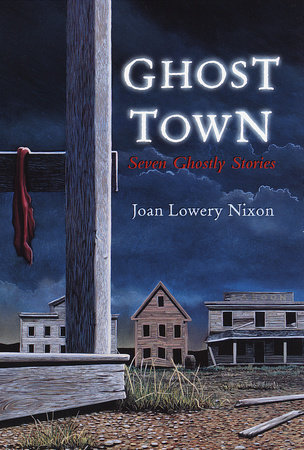Excerpt
Ghost Town
WHO ARE THE GHOSTS?
Hundreds of ghost towns are scattered across our Western states like dried, crumbling leaves after a winter windstorm. Thick adobe walls have weathered thin. Wooden posts and flooring have decayed. And even sturdy stone buildings have given in to the battering elements, their ragged remains marking the places where people once lived and worked.
Only a few of the ghost towns have been saved, their buildings repaired and painted so that visitors can catch a glimpse of Western life in the 1800s.
Most of the towns were established by miners hungry for their share of profits in the newly discovered veins of gold and silver. As time went on, however, some of these towns became hideouts for desperados. And there were a few in which groups of people attempted to establish other profitable industries and failed.
Miners, mountaineers, gunfighters, shady ladies, schoolteachers, preachers and their wives, workers and their families populated the towns. When the gold and silver were gone, the residents abandoned the towns.
Tourists from all over the world are not only curious about the Old West, but also fascinated by the stories behind each ghost town. Whether visitors believe in ghosts or not, once inside a ghost town, eerie feelings often engulf them. Just as sitting around a campfire listening to ghost stories makes you more aware of scary sounds, encountering a ghost in an abandoned town begins to seem quite possible.
Here are seven stories about real ghost towns in the West. Enter each town and walk its lonely streets lined with decaying buildings. See the shadows, and hear the whispers of those who seem unable to let go of their pasts.
These are the ghosts.
the Shoot-out
Chip Doby slumped in the backseat of his family's van. He wanted to be home in Phoenix with his best friends, Carlos and Dan. They'd saved enough from their allowances to spend all Saturday at the arcade. He'd saved, too, but a fat lot of good it had done him.
"Tomorrow we're taking a family trip to the town of Tombstone," Chip's mother had announced at breakfast on Friday. "We think everyone will enjoy a family outing."
"Tomorrow! But that's Saturday!" Chip's cereal spoon had fallen to the table, spattering milk and soggy Krispies across his T-shirt.
His little sisters had giggled.
"Sloppy, sloppy," ten-year-old Abby had chanted, while seven-year-old Emily had made a face.
But Mrs. Doby had said, "You'll love it." She'd beamed with excitement. "It will be great fun to see this historic Western town, and it will be painlessly educational, too. It was named a National Historic Landmark by the United States Department of the Interior back in the sixties."
Chip had groaned and dropped his forehead to the table, narrowly missing what was left of his cereal. "Tomorrow's Saturday," he'd said. "I'm supposed to hang out with Carlos and Dan."
"This is a marvelous opportunity, Chip," his mother had answered patiently. "You can walk the streets of the town, visit the restored buildings, and see the people in costume. During the day they even have make-believe shoot-outs. It's a wonderful look at the Old West in Arizona. Believe me, you're going to enjoy it."
"Enjoy national historic stuff? Sure."
"Charles, sit up," his father had said in a tone of voice that showed he meant business. As Chip had sat back in his chair, his dad had handed him a clean spoon. "And finish your breakfast. Your mother is right. You're going to enjoy the history of this trip. Tombstone is where the famous Gunfight at the O.K. Corral took place, with Wyatt Earp and his brothers and Doc Holliday."
Chip had groaned again. "Dad, I can't go. I promised the guys--"
Mr. Doby had frowned, so Chip had turned quickly to his mother. "Mom, how long is this trip?"
"Only for the weekend," she'd said. "We'll be home Sunday evening."
"Then let me stay here alone," Chip had pleaded. "I'm not a little kid. I'm thirteen. I'm old enough to take care of myself."
"Out of the question," Mr. Doby had said.
Chip hadn't wanted to give up that easily. "Look, every week I mow Mr. Banks's lawn and ours, and last week I helped put a coat of stain on the backyard deck. You told me I did a good job. You said I was responsible. So if you meant what you said, then why can't I be responsible enough to stay by myself?"
"I did mean what I told you," Mr. Doby had answered. "You've proved to be highly responsible in handling the jobs you've taken on, but that has nothing to do with your staying here in the house alone. You're just not old enough, Chip."
Chip had looked at his mother. "Mom--"
"Our decision has been made, and we'll hear no more about it," Mr. Doby had said. "Do you understand?"
"Yeah," Chip had mumbled, but he really hadn't understood. As he sat in the car, riding through southern Arizona, all he thought about was the unfairness of it all.
Off to the west lay brown, scrubby, low mountains and hills--the southern end of the Rocky Mountains that dribbled off like a gigantic brown lizard's tail. Ahead, along Interstate 80, which stead-ily climbed in altitude through the desert landscape, stood a few colorful billboards advertising the route to Tombstone.
As Mrs. Doby began reading aloud from her guidebook about the history of Tombstone, Chip wished he could plug up his ears. Instead he had to hear about some miner from a million years ago who was told that the only thing he'd ever get out of his property was his tombstone. So he jokingly called his mine and his town Tombstone. So what?
All Chip could think about was Dan and Carlos having fun without him at the arcade. They'd be playing Deadly Aliens, and he wouldn't.




